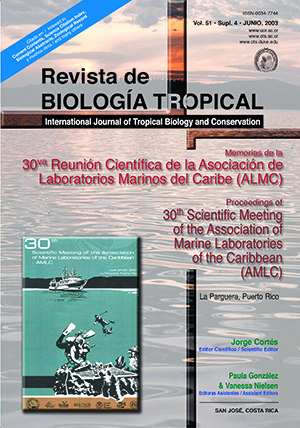Abstract
In order to evaluate if snorkeling had significant effects on coral community structure, three different coral reefs (Madrizquí, Pelona de Rabusquí and Crasquí) located at Archipelago Los Roques National Park, Venezuela, were surveyed. For each site, the coral community structure of two different areas, one subjected to intense snorkeling use (FB) and other not frequently used (PFB), were compared. Community structure was determined with 1 m2quadrants and 20 m-long transects. These communities were described in terms of species richness, diversity (Shannon–Wiener) and evenness indexes, live and dead coral cover and cover of other organisms (sponges, octocorals and algae). Comparisons within sites were performed with a Kruskall – Wallis test. A total of 24 species of scleractinian corals were found. Live coral cover ranged from 29.9% ± 26.43 (Crasquí) to 34.55% ± 6.43 (Madrizquí), while dead coral cover ranged from 32.51% ± 2.86 (Madrizquí) to 60.78% ± 21.3 (Pelona de Rabusquí). The PFB areas showed higher live coral cover compared to FB areas; however, significant differences were only found in Crasquí and Pelona de Rabusquí (p < 0.05). Species richness, diversity and evenness were variable and no trends were observed between FB and PFB areas. The frequency of both damaged and diseased colonies were low (< 1%), most damages observed were natural (parrotfish predation). Damages caused by divers such as fin impacts, were not found at the reefs studied. These results suggest that, currently, diving pressure is not as high to cause massive loses of live coral cover in these reefs. However, the lack of strict controls for these activities might produce long-term changes in the structure of these coral communities.References
Allison, W.R. 1996. Snorkeler damage to reef corals in the Maldive Islands. Coral Reef 15: 215-218.
Amend, T. 1992a. Los habitantes del Archipiélago de Los Roques en el pasado y el presente, p. 1-42 In T. Amend (ed.). Fundación Polar, Parque Nacional Archipiélago Los Roques, INPARQUES, Caracas.
Amend, T. 1992b. Chances y problemas en el manejo del Parque Nacional Los Roques, p. 109-144 In T. Amend (ed.). Fundación Polar, Parque Nacional Archipiélago Los Roques, INPARQUES, Caracas.
Barrios, L., J. Garzón-Ferreira & S. Zea. 1999. Evaluación de las principales condiciones de deterioro en algunas formaciones coralinas de la plataforma continental del Caribe. 29va Reunión de la Asociación de Laboratorios Marinos del Caribe, Cumaná, Venezuela. Resumen: p. 93.
Chadwick–Furman, N.E. 1997. Effects of scuba diving on coral reef invertebrates in the U.S. Virgin Islands: implications for the management of diving tourism. Proc. 6th Int. Conf. Coel. Biol.: 91-100.
Cróquer, A. & E. Villamizar. 1998. Las variaciones de la pendiente topográfica, un factor a considerar en la evaluación de la estructura de una comunidad. Rev. Biol. Trop. 46 (Supl. 5): 29-40.
Dixon, J.A. 1993. Economic benefits of marine protected areas. Oceanus 36: 35-40.
Harriott, V.J., D. Davis & S.A. Banks. 1997. Recreational diving and its impact in marine protected areas in Eastern Australia. Ambio 26: 174-179.
Hawkins, J.P. & C.M. Roberts. 1992. Effects of recreational scuba diving on fore-reef slope communities of coral reef. Biol. Conser. 62: 171-178.
Hawkins, J.P. & C.M. Roberts. 1993. Effects of recreational scuba diving on coral reefs: trampling on reefflat communities. J. Appl. Ecol. 30: 25-30.
Hawkins, J.P. & C.M. Roberts. 1997. Estimating the carrying capacity of coral reefs for scuba diving. Proc 8th Int. Coral Reef Symp., Panamá 2: 1923-1926.
Hung, M. 1985. Los corales pétreos del Parque Nacional Archipiélago de Los Roques. Tesis de licenciatura, Escuela de Biología, Univ. Central de Venezuela, Caracas, Venezuela. 204 p.
Muthiga, N.A. & T.R. McClanahan. 1997. The effect of visitor use on the hard coral communities of the Kisite Marine Park, Kenya. Proc. 8th Int. Coral Reef Symp., Panamá 2: 1879-1882.
Rouphael, T.B. 1994. Coral reefs and scuba divers, identifying and assessing the effects of scuba divers on hard coral assemblages. Reef Res. December 1994: 10-12.
Russ, G.R. & A.C. Alcalá. 1999. Management histories of Sumilon and Apo Marine Reserves, Philippines, and their influence on national marine resource policy. Coral Reefs 184: 307-319.
Schleyer, H.M. & B.J. Tomalin. 2000. Damage on South African coral reefs and assessment of their sustainable diving capacity using a fisheries approach. Bull. Mar. Sci. 67: 1025-1042.
Sorokin, Y.I. 1995. Coral Reef Ecology. Springer, Berlín. 465 p.
Talge, H. 1992. Impact of recreational divers on scleractinian corals at Looe Key, Florida. Proc. 7th Int. Coral Reef Symp. Guam 2: 1077-1081.
Tilmant, J.T. & G.P. Schmahl. 1981. A comparative analysis of coral damage on recreationally used reefs within Biscayne National Park, Florida. Proc. 4th Int. Coral Reef Symp., Manila 1: 187-192.
Woodley, J.D., S.R. Smith, J. Garzón-Ferreira, K.H. Koltes, P. Alcolado, K. Bonair, D. Bone, K. Buchan, K. De Meyer, J.R. García, P. Gayle, F.X. Geraldes, E. Jordan-Dahlgren, E. Krobbe, E. Klein, R. Laydoo, F. Losada, G. Ostranden, H. Oxenfond, C. Parker, L.P.J.J. Pors, F. Ruiz-Renteira, J. Ryan, J. Tschirky & R. Varela. 1997. CARICOMP, Monitoring of Coral Reefs. Proc. 8th Int. Coral Reef Symp. Panamá 1: 651656.
Zubillaga, A. L. 2001. Evaluación del efecto de las actividades de buceo recreativo en la estructura comunitaria de algunos arrecifes coralinos del Parque Nacional Archipiélago de Los Roques. Tesis de licenciatura, Esc. de Biología, Univ. Central de Venezuela, Caracas, Venezuela. 121 p.
##plugins.facebook.comentarios##

This work is licensed under a Creative Commons Attribution 4.0 International License.
Copyright (c) 2003 Revista de Biología Tropical


